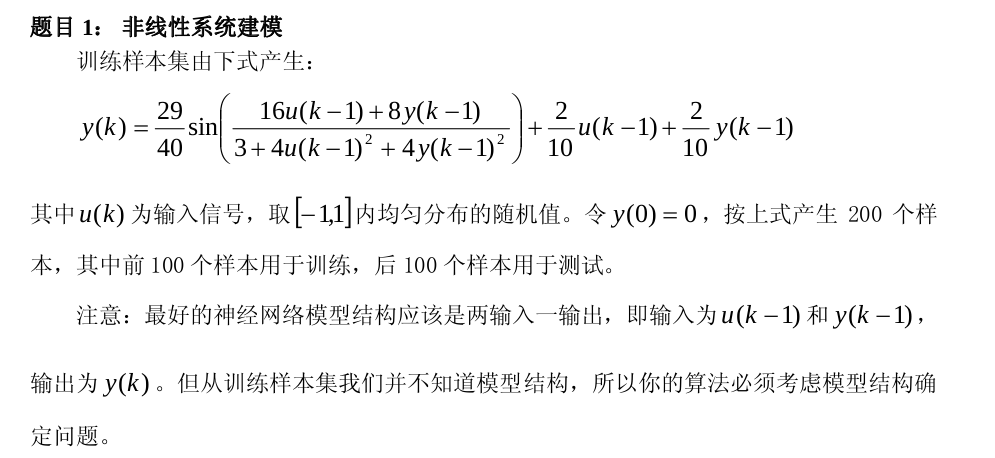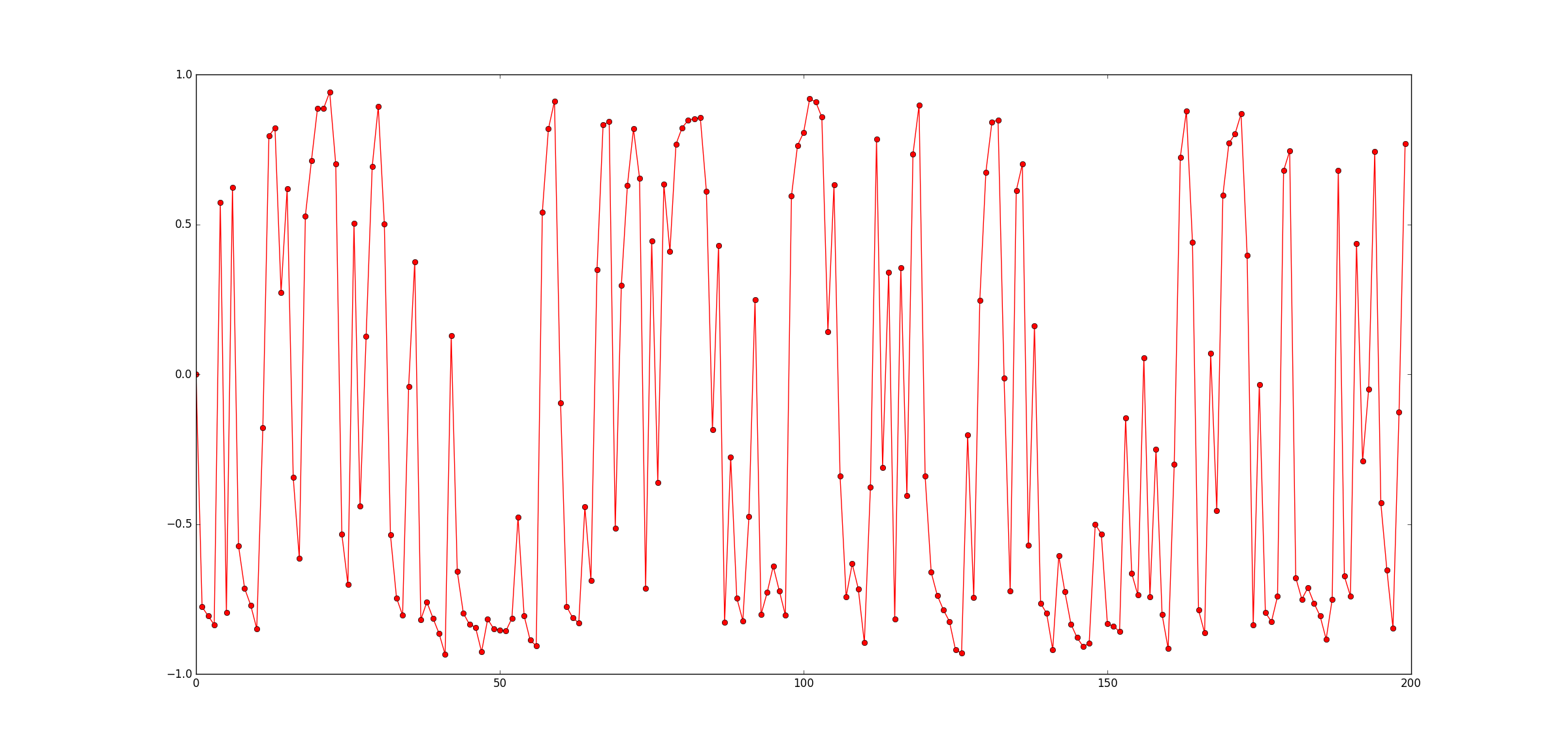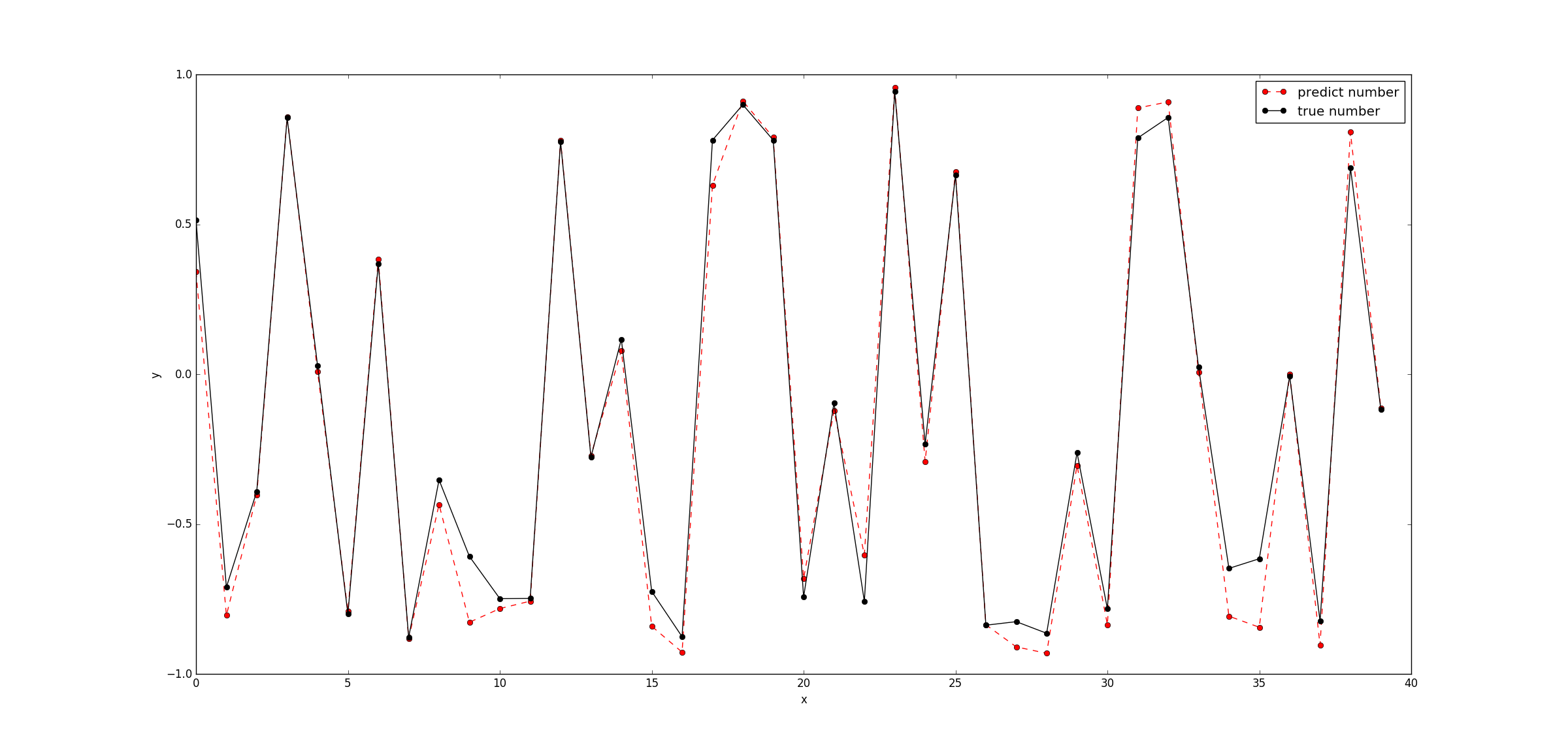Pybrain是一个比较有名的Python神经网络库,今天我用它做了一个实验,参考了这篇博客,感谢原作者,给出了具体的实现,代码可以直接拷贝运行。
我们的问题主要如下:

首先我们给出构造生成这个题目要求的数据集的函数
def generate_data():
"""generate original data of u and y"""
u = np.random.uniform(-1,1,200)
y=[]
former_y_value = 0
for i in np.arange(0,200):
y.append(former_y_value)
next_y_value = (29 / 40) * np.sin(
(16 * u[i] + 8 * former_y_value) / (3 + 4 * (u[i] ** 2) + 4 * (former_y_value ** 2))) \
+ (2 / 10) * u[i] + (2 / 10) * former_y_value
former_y_value = next_y_value
return u,y
这个题目的函数画出来是这样子的:

我们的例子,就是用前100个点训练,后100个点作为预测。
构建Pybrain神经网络的基本步骤:
- 构建神经网路
- 构造数据集
- 训练神经网络
- 结果可视化
- 验证和分析
构造神经网路
构建神经网络的过程非常清晰,设置几个层次,几个节点,都简单明了,看一次就会了。
import numpy as np
import matplotlib.pyplot as plt
from pybrain.structure import *
from pybrain.datasets import SupervisedDataSet
from pybrain.supervised.trainers import BackpropTrainer
# createa neural network
fnn = FeedForwardNetwork()
# create three layers, input layer:2 input unit; hidden layer: 10 units; output layer: 1 output
inLayer = LinearLayer(2, name='inLayer')
hiddenLayer0 = SigmoidLayer(10, name='hiddenLayer0')
outLayer = LinearLayer(1, name='outLayer')
# add three layers to the neural network
fnn.addInputModule(inLayer)
fnn.addModule(hiddenLayer0)
fnn.addOutputModule(outLayer)
# link three layers
in_to_hidden0 = FullConnection(inLayer,hiddenLayer0)
hidden0_to_out = FullConnection(hiddenLayer0, outLayer)
# add the links to neural network
fnn.addConnection(in_to_hidden0)
fnn.addConnection(hidden0_to_out)
# make neural network come into effect
fnn.sortModules()构建数据集
我们选择2输入1输出,80%用于训练,20%用于预测
# definite the dataset as two input , one output
DS = SupervisedDataSet(2,1)
# add data element to the dataset
for i in np.arange(199):
DS.addSample([u[i],y[i]],[y[i+1]])
# you can get your input/output this way
X = DS['input']
Y = DS['target']
# split the dataset into train dataset and test dataset
dataTrain, dataTest = DS.splitWithProportion(0.8)
xTrain, yTrain = dataTrain['input'],dataTrain['target']
xTest, yTest = dataTest['input'], dataTest['target']训练神经网路
我们暂且让他迭代1000次
# train the NN
# we use BP Algorithm
# verbose = True means print th total error
trainer = BackpropTrainer(fnn, dataTrain, verbose=True,learningrate=0.01)
# set the epoch times to make the NN fit
trainer.trainUntilConvergence(maxEpochs=1000)结果可视化
我们用matlibplot画出来这个预测值和实际值
predict_resutl=[]
for i in np.arange(len(xTest)):
predict_resutl.append(fnn.activate(xTest[i])[0])
print(predict_resutl)
plt.figure()
plt.plot(np.arange(0,len(xTest)), predict_resutl, 'ro--', label='predict number')
plt.plot(np.arange(0,len(xTest)), yTest, 'ko-', label='true number')
plt.legend()
plt.xlabel("x")
plt.ylabel("y")
plt.show()我们拿这个题目来做一下预测,画出来的图形如下
分析
for mod in fnn.modules:
print ("Module:", mod.name)
if mod.paramdim > 0:
print ("--parameters:", mod.params)
for conn in fnn.connections[mod]:
print ("-connection to", conn.outmod.name)
if conn.paramdim > 0:
print ("- parameters", conn.params)
if hasattr(fnn, "recurrentConns"):
print ("Recurrent connections")
for conn in fnn.recurrentConns:
print ("-", conn.inmod.name, " to", conn.outmod.name)
if conn.paramdim > 0:
print ("- parameters", conn.params)它可以打印出来神经网络的具体信息,结果如下:
Module: hiddenLayer0
-connection to outLayer
- parameters [-0.48485978 1.94439991 -1.1686299 -1.01764515 -1.04221 -0.78088745
0.27321985 -1.76426041 2.0747614 1.98425053]
Module: inLayer
-connection to hiddenLayer0
- parameters [ 1.48125364 -0.97942827 4.7258546 2.08059918 -1.96960441 -0.03098871
0.52430318 1.64983933 0.43738152 1.95122015 0.81952423 -0.24019787
-0.86026329 0.63505556 0.53870484 0.94078527 1.42263437 1.87720358
-1.12582038 0.70344489]
Module: outLayer完整的代码
最后,我把完整的代码贴出来,注意,你要先安装pybrain才行
import numpy as np
import matplotlib.pyplot as plt
from pybrain.structure import *
from pybrain.datasets import SupervisedDataSet
from pybrain.supervised.trainers import BackpropTrainer
def generate_data():
"""generate original data of u and y"""
u = np.random.uniform(-1,1,200)
y=[]
former_y_value = 0
for i in np.arange(0,200):
y.append(former_y_value)
next_y_value = (29 / 40) * np.sin(
(16 * u[i] + 8 * former_y_value) / (3 + 4 * (u[i] ** 2) + 4 * (former_y_value ** 2))) \
+ (2 / 10) * u[i] + (2 / 10) * former_y_value
former_y_value = next_y_value
return u,y
# obtain the original data
u,y = generate_data()
# createa neural network
fnn = FeedForwardNetwork()
# create three layers, input layer:2 input unit; hidden layer: 10 units; output layer: 1 output
inLayer = LinearLayer(2, name='inLayer')
hiddenLayer0 = SigmoidLayer(10, name='hiddenLayer0')
outLayer = LinearLayer(1, name='outLayer')
# add three layers to the neural network
fnn.addInputModule(inLayer)
fnn.addModule(hiddenLayer0)
fnn.addOutputModule(outLayer)
# link three layers
in_to_hidden0 = FullConnection(inLayer,hiddenLayer0)
hidden0_to_out = FullConnection(hiddenLayer0, outLayer)
# add the links to neural network
fnn.addConnection(in_to_hidden0)
fnn.addConnection(hidden0_to_out)
# make neural network come into effect
fnn.sortModules()
# definite the dataset as two input , one output
DS = SupervisedDataSet(2,1)
# add data element to the dataset
for i in np.arange(199):
DS.addSample([u[i],y[i]],[y[i+1]])
# you can get your input/output this way
X = DS['input']
Y = DS['target']
# split the dataset into train dataset and test dataset
dataTrain, dataTest = DS.splitWithProportion(0.8)
xTrain, yTrain = dataTrain['input'],dataTrain['target']
xTest, yTest = dataTest['input'], dataTest['target']
# train the NN
# we use BP Algorithm
# verbose = True means print th total error
trainer = BackpropTrainer(fnn, dataTrain, verbose=True,learningrate=0.01)
# set the epoch times to make the NN fit
trainer.trainUntilConvergence(maxEpochs=1000)
# prediction = fnn.activate(xTest[1])
# print("the prediction number is :",prediction," the real number is: ",yTest[1])
predict_resutl=[]
for i in np.arange(len(xTest)):
predict_resutl.append(fnn.activate(xTest[i])[0])
print(predict_resutl)
plt.figure()
plt.plot(np.arange(0,len(xTest)), predict_resutl, 'ro--', label='predict number')
plt.plot(np.arange(0,len(xTest)), yTest, 'ko-', label='true number')
plt.legend()
plt.xlabel("x")
plt.ylabel("y")
plt.show()
for mod in fnn.modules:
print ("Module:", mod.name)
if mod.paramdim > 0:
print ("--parameters:", mod.params)
for conn in fnn.connections[mod]:
print ("-connection to", conn.outmod.name)
if conn.paramdim > 0:
print ("- parameters", conn.params)
if hasattr(fnn, "recurrentConns"):
print ("Recurrent connections")
for conn in fnn.recurrentConns:
print ("-", conn.inmod.name, " to", conn.outmod.name)
if conn.paramdim > 0:
print ("- parameters", conn.params)文章引用:
[1]用Pybrain库进行神经网络拟合























 6475
6475











 被折叠的 条评论
为什么被折叠?
被折叠的 条评论
为什么被折叠?








